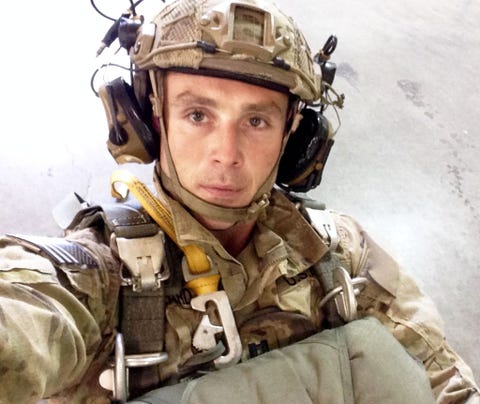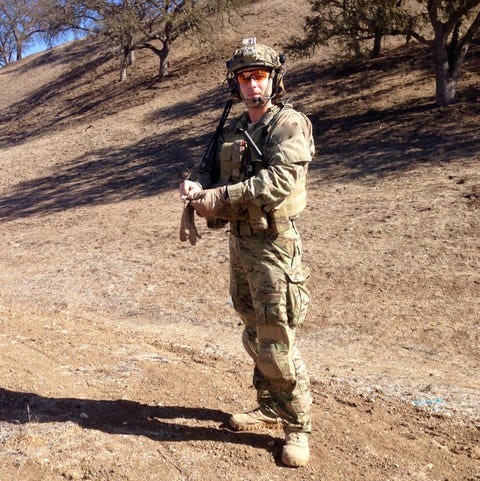How You Can Treat a Victim of a Gunshot Wound
Throughout history, the battlefield has been key to civilian medical advancement— think vaccines, antibiotics, and the ambulance service, to name a few. In recent years, trauma care has dramatically improved through a few simple changes that, unfortunately, are now relevant in the civilian world. In 2018 alone, there were 323 mass shootings—defined as four or more people shot in the same location at roughly the same time—in the U.S. Last year also marked more school shootings than ever before, and for the first time in American history, the public school system is on record to do more lock down drills than fire drills.

I’m writing about combat and civilian casualties because of my background. I was part of the Army 75th Ranger Regiment for five years. It’s a light infantry special operations unit regarded as the Army’s premier direct action raid force. Personally, I’m partial to what our Afghan interpreter informed me the locals called us: “The men with the green eyes who come in the night,” referencing the glow of our night vision goggles. Of my five years on active duty, two were spent full-throttle serving as a Battalion Surgeon in the 75th Ranger Regiment.

What drew me to pursue serving as a surgeon with the Rangers? The unrelenting standards. Elsewhere in the special operations, the soldiers are split between “operators,” the bad asses coming out of the water in recruiting commercials, and “support” for which there are different training requirements. Not in the Rangers. Every soldier must uphold the minimum physical, marksmanship, and airborne standards regardless of rank and function. Prior to my arrival, my unit went for 18 months without a doctor because physicians go through the same selection process as other Ranger leaders and kept failing.
These standards are the reason Rangers are so good at saving lives on the battlefield. I’m now an emergency room physician and gave a lecture to the emergency physicians at a respected major trauma center and shared an unwelcome truth: If I got shot outside the hospital I would rather have a team of non-medical, high-school educated Rangers take care of me than any group of ER doctors. The reason? Rangers are drilled to be fast and efficient. I have clear memories of repeat training iterations well past midnight involving assessing, treating, and evacuating casualties using night vision in the midst of flash bang grenades, live machine gun fire, and rotor wash from nearby helicopters.

Between October 2001 and March 2010, the 75th Ranger Regiment sustained 419 battlefield casualties during over 8,000 combat missions in Afghanistan and Iraq. In spite of overall greater injury severity, the Rangers had significantly better outcomes than the rest of the Department of Defense. Additionally, of the 32 combat deaths, none were considered preventable after action review, meaning that the Ranger’s life could not have been saved by any change in pre hospital medical care. These statistics were so impressive that they shifted the entire paradigm of American military trauma care.
Tactical Combat Casualty Care, or TCCC is the basis of this shift. Time counts in trauma and the focus of TCCC is on broadening out the responsibility of initial care beyond the few medical personnel out to everyone, and a huge number of lives have been saved because of it. Full training involves a multi-day intensive course, but simple scene safety and the three points below are absolutely enough to save a fellow human should you be unfortunate enough to have the option to act.
1) Stay Safe Yourself
This is by far and away the most important principle. I want to reemphasize this: Do not add to the problem. Until the threat is neutralized, you need to maintain cover and do all you can to prevent being shot yourself. This is not just for yourself—if you become a casualty while attempting to do a great thing, you are further stressing the available medical resources and are decreasing the chance of others being treated in time.
2) Stop the Bleeding
Extremity wounds are the number one cause of preventable combat death. Extremity bleeding is stopped by use of a tourniquet rapidly applied painfully tight and as high up on the extremity as possible way above the actual wound. Bullets can track weird courses; think J.F.K.. The initial tourniquet should be put on rapidly, over the clothes and as near the torso as possible to keep the blood near vital organs. There are numerous effective products, but the CAT tourniquet is the best known and costs around $20 on Amazon. I keep a few in my vehicle. A belt or whatever else you can tie around is secondary option, but has to be tight, like really tight. Do not worry about killing the limb with a tourniquet; hours can safely pass before any real damage occurs.

Treat shots in junctional areas—places you can’t get a tourniquet on, but it’s possible to compress, like the groin, armpit, and near the neck—with pressure. Focused pressure is the most effective, a finger tip where the bleeding is coming from is far better than a huge gob of bandages that slowly soak with large quantities of blood. I have gone un-sterile into the operating room with my hand inside my patient’s neck to prevent further blood loss from a slit throat.
Shots in the “box” (torso and abdomen) need a surgeon. Period. Your best care is to get them to a hospital ASAP. If there are a lot of people injured the ambulance service can be overwhelmed and going by private vehicle is totally appropriate and often life saving. In penetrating trauma, gunshots and stabs, you do not need to worry about preventing spinal injury, just get them to a vehicle and go.

Getty Imagessimonkr
2) Treat a Sucking Chest Wound.
A penetrating injury to the chest or upper abdomen needs a simple plastic covering to prevent a rapidly fatal complication called a tension pneumothorax. This is where with each breath air gets sucked in through the wound and gets trapped in the chest cavity progressively raising the intrathoracic pressure and collapsing the lung and large veins returning to the heart. The dressing can be simple, a candy bar wrapper, zip lock bag, etc. held or duck taped over the wound.
3) Provide Warmth
Keep the casualty warm with a blanket, ideally, but coats, the shirt off your back, or whatever else you have around will work. Blood loss and injury causes decreased body temperature even in really warm environments. This causes what textbook’s describe as the coagulopathy of trauma. Basically, your body’s natural process to stop bleeding is dependent on enzymatic reactions that are slowed or stopped by cold. So you can drastically reduce the overall blood loss by keeping the casualty warm and allowing their body to do its part.
The simple steps in this article are absolutely enough to save a life without further medical training. If you want to take it a step further, Citizen Aid has slimmed down the military’s casualty care training system for civilians. They focus on the initial life saving minutes before professional help arrives and offer a free “what to do in a shooting” phone app, trauma supply kits, and a one-hour $14 online training with a 1:1 matching incentive which trains a teacher.
Action is the first step to being a hero. Not long ago, in a state-of-the-art, fully resourced emergency room trauma bay, I was unable to bring back a healthy male in his early 20s with a simple gunshot to the leg. He bled to death in the middle of the day on a busy street full of good people. Literally just one person going up and taking action, either by putting a tourniquet on his thigh or even just jamming a shirt hard into the injury with a thumb, would have saved his life. Take action, my friends.
Source: Read Full Article



